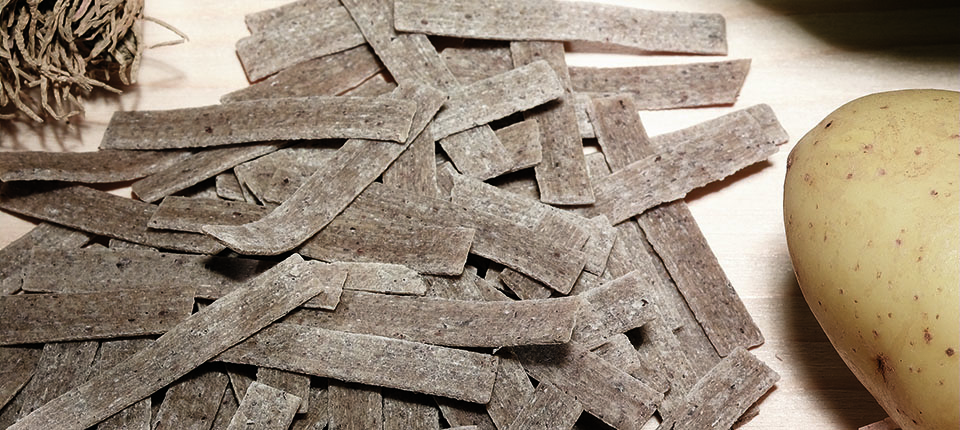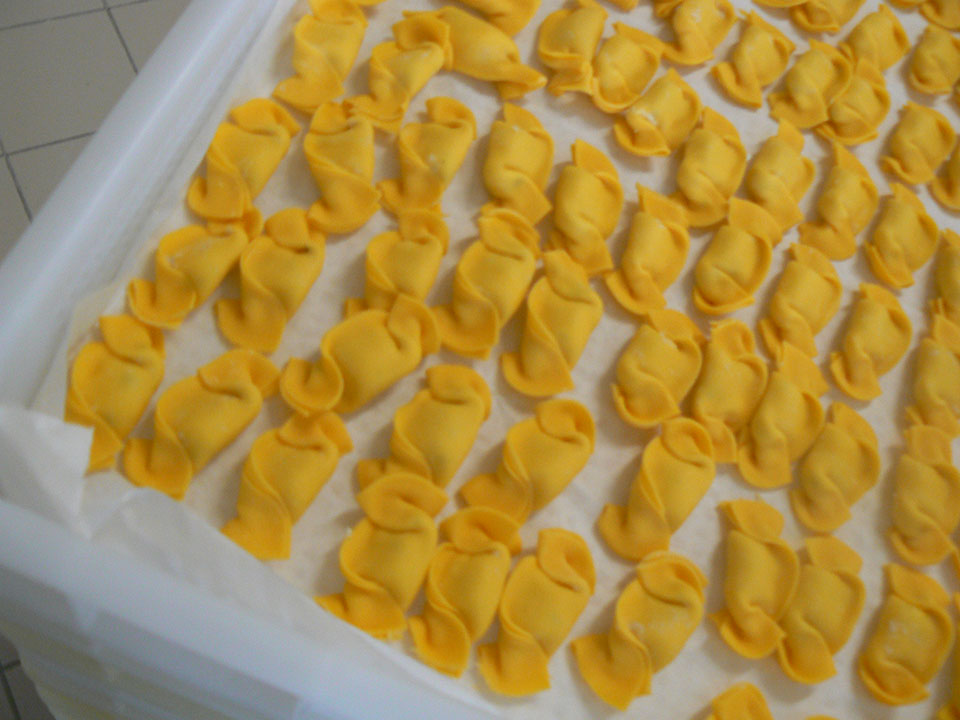
Fresh pasta for celiacs with buckwheat
26 April 2012These are the results of a recent study into the development and promotion of buckwheat, which has led to the creation of a product which is similar to fresh pasta yet gluten-free.
by Cristina Alamprese
Many people suffer from gluten intolerance, a condition known as Celiac disease. According to the Italian Celiac Association (www.celiachia.it), the incidence of this intolerance in Italy is estimated at around one in 100/150 people. There may therefore potentially be around 400,000 celiacs in Italy, although only around 85,000 have been diagnosed up till now. Every year 5,000 new diagnoses are carried out and 2,800 new sufferers identified, with an annual increase of around 10%. The disease is manifested by a typical lesion of the mucous membrane in the proximal small intestine, which causes chronic inflammation and progressive atrophy of the intestinal villi. Excluding gluten from the diet of celiacs is currently the only treatment that fully restores the normal mucous membrane structure.
Gluten is a protein complex present in foods containing cereals, which is formed by the interaction of two protein fractions (prolamin and glutelin) following hydration and the mechanical action of kneading. Gliadins (the prolamin fraction of wheat) are the most toxic proteins for celiacs, but prolamins from other cereals (including rye, triticale and barley) are also harmful to gluten intolerance sufferers. The proteins in cereals including rice, corn and buckwheat are not however toxic.
A gluten-free diet requires great efforts in terms of nutritional education and is not easy to implement, as it requires the exclusion of some of the primary foods in the so-called Mediterranean diet, such as bread and pasta, but also pizza, biscuits and cake. Alongside these foods which are commonly associated with wheat, other forbidden foods also include those which only apparently do not contain cereals, such as creams, ice cream and sweets, which can however contain traces of gluten deriving from the use of ingredients obtained from wheat (such as starch or glucose syrup). The choice of foods is further narrowed by the need to also exclude products containing toxic cereals, including rye, barley, spelt, Kamut (khorasan wheat), triticale and oats.
Foods are available on the market which are suitable for consumption by celiacs (with gluten contents of less than 20 ppm): these carry a special mark on the package (figure 1), a symbol registered and owned by the Italian Celiac Association which since the late 1990s has begun to grant the use of the ‘crossed-out ear of wheat’ in a controlled manner. The range includes foodstuffs such as pasta, bread, cakes and sweets, bread sticks, crackers, frozen pizzas, ready meals and various kinds of flours, adapted specifically for the production of different kinds of food products. Unfortunately these products do not always excel in their sensorial properties, as gluten plays a very important role in the structural characteristics which are so popular among consumers. In leavened bakery products, for example, the presence of the gluten network effectively withholds the carbon dioxide produced by the yeast or the reaction of other raising agents, making the dough rise to a good size and in a uniform manner. As pasta is cooked, the gluten limits the imbibition of the starch granules and the consequent release of amylose into the cooking water, with positive repercussions on the firmness of the product during cooking, assuring less sticky and more consistent results.
As it is not possible to technologically promote the formation of the gluten network, production technologies have to be used which enhance the structure of starch (for example, pregelatinization) or the use of raw materials which may have structural features that are similar to gluten (such as eggs, xanthan gum, methyl cellulose).
Buckwheat not only does not contain gluten-forming proteins, it also possesses other interesting nutritional properties, such as the presence of proteins with a high biological value, anti-oxidant substances, fiber, vitamins (above all in group B) and minerals. To best preserve these nutritional properties, it is preferable to use buckwheat in products which do not undergo prolonged heat treatments.
A study was carried out at the Department of Food and Microbiological Sciences and Technologies at the University of Milan (DISTAM) to exploit the potential of buckwheat, which has led to the development of two kinds of products:
• fresh pasta containing wheat flour with a high percentage of buckwheat;
• products similar to fresh pasta classifiable as gluten-free, made from buckwheat and rice flours.
Various formulas were produced in the laboratory in the form of lasagna sheets, using an artisanal fresh pasta production system, and those which offered the most interesting results were also produced industrially, with the cooperation of the Fontaneto pasta company (Fontaneto d’Agogna, Novara, Italy).
Table 1 shows the tested formulas and their ID codes. The numbers in the codes refer to the relative percentages of the flours used. The products marked in red are those which have also been experimented industrially (these will then be marked by an I- at the start of the code). In the gluten-free products, a higher quantity of egg product was used and the wheat flour (indicated by the letter F) was replaced by hulled buckwheat flour (indicated by the letter S) and various rice flours: rice flour (R), pregelatinized rice starch (AR), precooked rice flour (RP).
In two gluten-free products, 0.5% of methyl cellulose was added, which is used to improve the structure of the gluten-free dough.
Figure 2 shows the composition of all samples produced and analyzed, in terms of moisture, proteins and fats. As far as the pasta produced in the laboratory was concerned, the two samples integrated with buckwheat (S40-F60 and S60-F40) show no substantial differences compared to the traditional products obtained exclusively using soft wheat flour (F100). Only the fat content is higher, due to the higher fat content in hulled buckwheat flour compared to wheat flour. The gluten-free samples also have a higher fat content compared to F100, due both to the contribution of the buckwheat but also the higher amount of egg mixture used to prepare them in order to obtain a better consistency of the dough. These doughs were also easier to work due to the increase in hydration levels: the moisture level in these samples is between 33 and 35%, compared to the 31% of the traditional sample and the products integrated with buckwheat. The protein content is similar in all samples, with the exception of the product obtained by replacing soft wheat flour with pregelatinized rice starch (S60-AR40), as this ingredient is almost totally protein-free (0.4% dry matter).
The samples produced industrially (highlighted in red in figure 2, page 24) do not, as expected, show any substantial differences in composition compared to the corresponding artisanally produced pasta. The only difference worthy of note concerns the moisture level, which is lower in the industrial samples due to the longer exposure to air during dough processing and pasteurization, which is carried out on the sheets both prior to and after packaging.
Figure 3 shows the data concerning the cooking behavior of the different analyzed samples, expressed in terms of solid residue released into the cooking water and the increase in weight of the sheets. The pasta integrated with buckwheat (samples S40-F60 and S60-F40) led to a greater loss during cooking (higher solid residue) than the traditional product (F100), due to the smaller amount of gluten in the dough and the larger amount of soluble fiber which tends to be washed out in the cooking water. The gluten-free samples recorded even higher solid residue values, due to the presence of soluble fiber, but above all due to the poor structural quality of rice flours compared to soft wheat flour: the absence of the gluten network promotes the imbibition of starch granules and the consequent release of amylose into the cooking water. In particular, the greatest losses during cooking were found in the sample produced using rice starch (S60-AR40), which is the poorest in protein.
In the artisanal samples, the highest weight increases were recorded in the pasta integrated with buckwheat, probably due to the greater fiber content, the particular conformation of the buckwheat starch grains and the lack of gluten. Among the gluten-free samples, the lowest weight increase values were recorded in the samples produced with pregelatinized rice starch (S60-AR40) or precooked rice flour (S60-RP40 and S60-RP40-M), confirming the fact that the use of pregelatinized ingredients can promote a better structure in this type of product.
The industrial samples are somewhat different, as the sheets were thicker than the laboratory-produced samples and had to be cooked for 6 minutes instead of 3. This is reflected in the solid residue and increase during cooking values, which are higher than the corresponding artisanal samples.
Figure 4 illustrates the results of the tensile tests carried out on the cooked sheets, expressed in terms of maximum load (resistance index) and deformation (extensibility index) to breakage.
First of all we can see how as the percentage of buckwheat increases, the sheets become less and less resistant and less extensible, as a result of the progressive reduction in gluten in the dough. As far as the gluten-free samples are concerned, the pasta produced using rice flour (S60-R40 and S60-R40-M) is more resistant and less extensible that the corresponding sample integrated with 60% buckwheat (S60-F40). The samples containing precooked rice flour (S60-RP40 and S60-RP40-M) are on the other hand more similar to S60-F40. The industrial production of these samples also offered good results, with products with acceptable mechanical indices (we should in fact consider that the data relates to a cooking time which is twice as long as that of the corresponding artisanal samples), but, above all, to a very workable sheet. In fact, although the samples broke very easily during lamination, this sample (I-S60-RP40) was found to be the most resistant, particularly those with the methyl cellulose based additive (I-S60-RP40-M). The use of this additive did not modify the quality parameters of the product, but rather their workability.
Conclusions
Both the fresh pasta samples integrated with buckwheat and the gluten-free samples showed significant differences to the traditional product obtained using only soft wheat flour, due to the low levels or absence of gluten. However, this work has demonstrated that a high quantity of egg mixture (30%) and the use of precooked rice flour produce a pasta which is similar to gluten-free fresh egg pasta, with acceptable quality features, similar to those of the corresponding sample produced with buckwheat and wheat flour. This indicates that the pregelatinization of rice flour improves the structuring properties of this ingredient. The tested formula was industrialized using methyl cellulose, which increases the resistance of the dough during processing. Finally, heat treatment and pasteurization improve the structure of the sheets, reducing deformation and increasing resistance.

